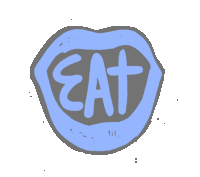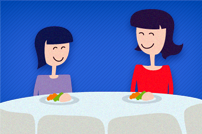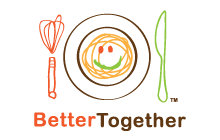Resources,
Online Resources
-
Making Meals Matter
There are a lot of benefits of eating meals together as a family. Read about some findings.
-
Mealtime Conversation Cards
Make Mealtime Family Time
A free downloadable set of conversation cards.
-
The Kids Cook Monday
The Kids Cook Monday provides examples of kid friendly recipes and video demonstrations along with nutrition and safety tips—making it easy for families to cook and eat together every Monday.
-
Meals This Week Planner
Plan your meals for the week with this print out.
-
HealthLink BC Food Safety Tips
HealthLink BC
Food poisoning affects hundreds of British Columbians every day. This document lists ten steps to make food safe.
-
Spatulatta: Cooking 4 Kids Online
Spatulatta teaches children to cook with free step-by-step videos. It encourages children to take pride in their accomplishments in the kitchen and to understand the connection between farm and dinner table. It also encourages children to ask their family members and friends for recipes and to cook those dishes together.
-
Jamie Oliver’s Ministry of Food
Jamie Oliver
Ministry of Food is all about getting people cooking again. It shows that anyone can learn to cook—and that it’s fun, cool, can save you money and help you, your family and friends to live a healthier life.
-
Eating Together
Heart & Stroke Foundation, Yukon & BC
This webpage addresses two common obstacles to family meals: time to cook and hectic schedules.
-
Cooking with Kids
EatRight Ontario
This webpage features helpful tips to make cooking with kids a big family hit. Tips are organized by children’s ages. Ten simple recipes are provided.
-
Rediscovering the Family Meal
Bernard Roy and Judith Petitpas, The Vanier Institute of the Family
This report explores the concept of “family meal” and eating habits from a sociological perspective.
-
Child Poverty in Perspective: An overview of child well-being in rich countries
Innocenti Report Card 7, UNICEF
This report looked at how well children and teens fare in various countries. Data was collected for 15-year-olds from 25 countries, including Canada. The report analyzes six dimensions: material well-being, health and safety, education, family and peer relationships, behaviours and risks, and sense of being loved, valued, and included in families and societies into which they were born. When looking at the best measure of family relationships, UNICEF used the marker “percentage of students whose parents eat their main meal with them around a table several times a week.”
-
Health Matters—Eat Better Together
Jill Rhynard, Interior Health, BC
This newsletter issue discusses the benefits to both children and adults when families eat together, provides tips for great family mealtimes and ideas for kid-approved quick and easy meals.
-
Family Newsletter
The Center for Mindful Eating
This newsletter series provides tips for enjoyable meals and introduces families to mindful eating.
-
Family Meals Focus E-Newsletter
Ellyn Satter, Registered Dietitian
Several issues of this newsletter provide guidance to families on how to have positive experiences at the dinner table. Note especially in the Archived newsletters the following issues: Focus #4: Family Meals Are Essential, Focus #5: Helping Family Get Back to the Table, and Focus #8: Answering Parents and Professionals Questions about Meals: Family-style meals.
-
Heart Healthy Eating Guide for Your Family
Heart and Stroke Foundation
This sixteen-page colour booklet provides simple tips and tools to help busy parents plan meals and make healthy choices with their children. It includes a helpful meal planner, a mix and match food group chart, grocery tips and kid-friendly recipes for family meals and recipes. It also includes activity tips and simple solutions to everyday challenges.
-
Healthy Eating and Active Living For Your 1 to 5 Year Old
Healthy U, Alberta Health and Wellness
This colourful twenty-eight-page booklet provides parents of toddlers and preschoolers with healthy eating tips and activity ideas to encourage their children to eat healthy and be active. It stresses the importance of families enjoying meals and activities together and parents modeling healthy eating and active living. Issues addressed include constipation, food allergies, food safety, picky eating, meal and snack planning, and healthy body image. It also includes a chart to map out the family activity plan, a sample menu plan and a list of activities to do.
-
Eat Better, Eat Together
Nutrition Education Network of Washington
This webpage features a kit that includes a research summary, brochures and strategies used in the Washington State initiative to promote family meals. Families can submit their successful family mealtime experiences through the 'Share your favourite family meal' feature.
-
Healthy Eating and Active Living For Your 6 to 12 Year Old
Healthy U, Alberta Health and Wellness
This colourful twenty-four-page booklet provides parents with healthy eating tips and ideas to encourage their 6 to 12 year-old children to eat healthy and be active. It stresses the importance of families enjoying meals and activities together and parents modeling healthy eating and active living. Issues addressed include creating healthy places and spaces, choosing and planning the right activities, meal and snack choices, eating out, food safety, food struggles, and healthy body self-image. It also includes a quiz to help families identify areas they can improve, a list of activities families can enjoy together, a chart to map out the family activity plan, a list of foods to choose from, a chart of school lunch ideas, and a list of snack ideas.
-
Can you give me ideas to help me plan healthy meals for my family and myself?
Dietitians of Canada
This webpage provides ten tips for planning healthy family meals.
-
Eat Together, Eat At Home
BC Medical Association
This document outlines the benefits of eating together at home.
-
Tasty Talk: 40 Mealtime Conversation Starters
Beth Marshall
A 4"x5" set of cards that includes some simple games.
-
Family Mealtimes Conversation Starters
Cattlemen's Beef Board and National Cattlemen's Beef Association
Simple, friendly conversation starter cards with three age groups in mind: toddlers, school-age children and adolescents.
-
Family Mealtime Conversation Cards
Iowa State University
A set of 40 cards that comes in a 5"x7" plastic bag. Each card provides a conversation starter in both English and Spanish.
-
30 Minute Skillet Meals
Adapted from Alberta Milk
Ideas for quick meals.
-
Screen Free Tips and Conversation Starters
Eat Right Montana
More mealtime conversation ideas.
-
Helping Your Toddler to Eat Well: Sharing the Responsibility with Your One to Three-Year-Old
HealthLink BC
This webpage gives helpful tips on how to approach different eating scenarios with small toddlers.
















